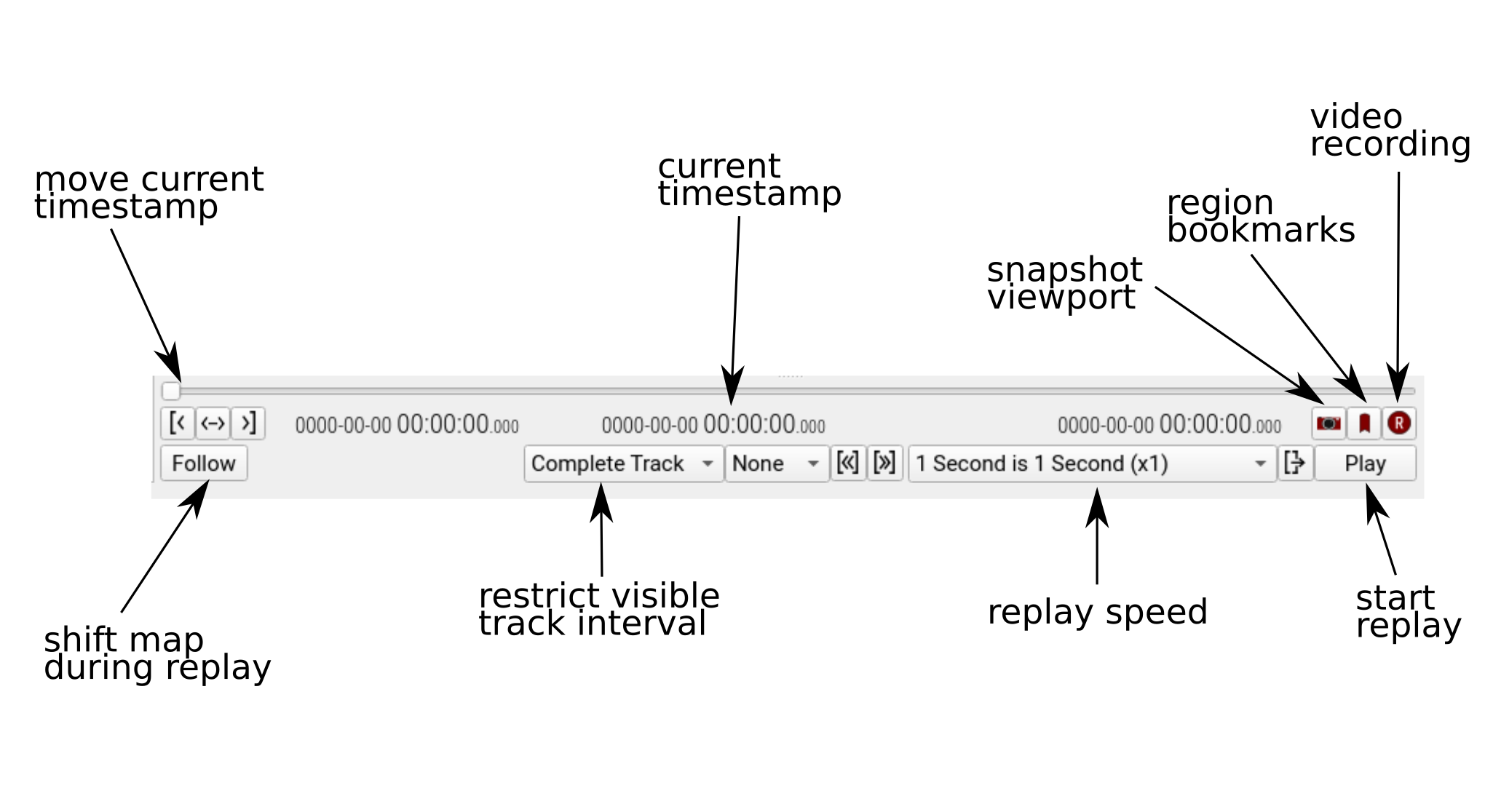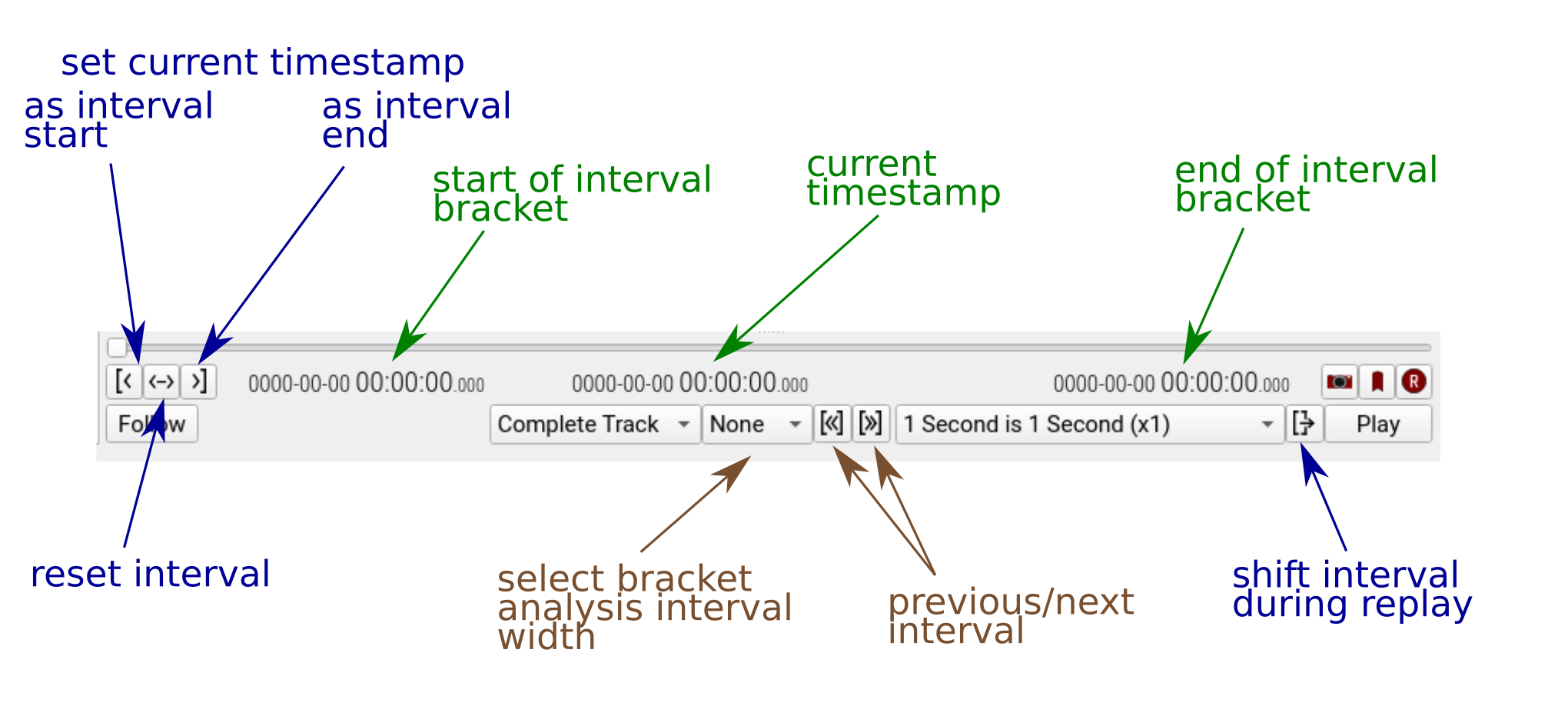Time control
The time control panel is an integral part of Firetail. It enables quick navigation of datasets.
Basic control overview

The measurement common to all Firetail data is the timestamp.
All sensor measurements are associated to a specific timestamp for a given tag, individual or deployment.
The data shown is centered around a user-defined current timestamp that implies the location and sensor measurements shown on the map.
On the map, Firetail highlights the coordinates associated to this timestamp for all selected individuals/tags.
- Press
lto toggle labels in the map - Press
cto toggle coordinates in the map
The current timestamp is set using the slider control in the main time control panel.
The exact timestamp is also shown numerically. Click on the timestamp to directly modify it.
The earliest available timestamp in the data is shown as Start Time.
The latest available timestamp in the data is shown as End Time.
Start and end timestamp also define the currently selected interval (see below).
Replay a dataset
Press Play to replay a dataset in real-time.
Switch the replay speed using the Replay speed dropdown menu in the main time control.
Selecting a timestamp from the map
In order to see when a given GPS coordinate was sent, you can double-click on a GPS trajectory drawn in the map view. The nearest timestamp will be selected as current timestamp.
Track traces (Firetails)
By default, the complete set of available locations for all selected entities is shown.
To restrict the context of the current timestamp, Firetail allows you to select a visible track interval (also termed Firetail length).
The track interval is controlled via the track interval dropdown menu and will restrict the context before the current timestamp to minutes, days or weeks, fading out gradually.
Synchronized GPS and Sensor Data
Acceleration data does not necessarily align to GPS data, for it may not exist for every GPS sample and vice versa. Instead, acceleration and high-density sensor data is often recorded as bursts that start at a defined timestamp.
Firetail will show sensor and location data in sync. Positions on the map are interpolated.
For acceleration data interpolaiton is not possible, but if no data is available, the sensor data panel will pause during replay.
Step-wise drill-down via intervals
To enable the precise selection of time windows for long-term data series, Firetail provides interval bracketing.

This principle is borrowed from video editing and allows for a step-wise refinement of intervals:
- change the current timestamp
- set a new start timestamp using
[< - change the current timestamp
- set a new stop timestamp using
>] - repeat to refine an interval
The slider will now be restricted to your new intervals.
Use the reset bracketing button <-> to unset the manual selection.
Note that after setting a shorter interval, the time slider precision is increased.
The restricted interval can be restricted further to enable fine-grained analysis.
A quick way to define an interval bracket of defined length set the step length, see Section Step Length
Use bookmarks to save interval brackets for later use.
Moving a fixed-length time window along the time axis
Use the  control to shift both the interval boundaries and the current timestamp when
control to shift both the interval boundaries and the current timestamp when Play is toggled.
This can be very useful for interactive visuals, like kernel densities KDE map.
Bookmarking
Firetail offers a bookmarking feature for both the selected time ranges and the selected set of individuals.
 Bookmarks Dialog
Bookmarks Dialog
Basic bookmarking
- Hit the
bookmarkicon in the time control section (keyboard shortcutCtrl-b) to open the bookmarks window - Hit the icon again or press
Ctrl-bto add a new bookmark for the current selection - Doubleclick a line to load this bookmark
When loading a bookmark, you may lose your selection of sensor checkboxes.
Check keep sensor states to
maintain the sensor selection of your Open Files tree.
Removing a bookmark
- Open the bookmarks window
- Hold
Ctrland left-click the line of the bookmark you wish to remove
Saving default bookmarks
- Create a set of bookmarks
- Press
Saveto save the current set of bookmarks as the default on startup
Saving bookmarks in specific files
You can save and share bookmarks:
- Open the bookmarks window
- Create a set of bookmarks
- Press
Save to...and navigate to a location for your bookmarks - Choose
.csvor.json; Note that.csvis export only (Excel etc.), json can be re-imported - Choose a name and confirm
Loading bookmarks from specific files
To load previously saved bookmarks, you may import .json bookmarks previously exported.
- Open the bookmarks window
- Press
Load from...and select a Firetail bookmarks file
To avoid loss of bookmarks this will add the bookmarks to the set of existing bookmarks.
Choose Clear bookmarks to remove any previous collection.
Bookmarks descriptions
Each bookmark offerst a note column that allows for entering custom text.
This column can hold annotations to effectively annotate the currently active set of individuals at a certain time.
Exporting as csv will allow downstream applications like R, matlab, SPSS and others to make
use of this data.
Follow an individual
Toggle Follow to enable automatic window scrolling. This will keep the currently selected individuals centered.
The zoom level does not change.
Manually setting timestamps
Firetail allows to edit timestamps as plain text. Click on either
- start time
- current time
- end time
to edit the timestamp.
Note that the Current Time cannot be
- earlier than the start time
- later than the end time
Similarly the
Start Timecannot be set after theCurrent TimeEnd Timecannot be set before theCurrent Time
Whenever start and end time are set manually time bracketing is active (timestamps are shown in blue). See Section focusing on a time window – bracketing for more details.
Note: Firetail works using ISO timestamps, so make sure to use
01instead of1
Step length
When analyzing data it is often required to step through your data with predefined
steps. When selecting a step length from the drop-down window (next to +, -)
bracketing is activated for the chosen interval (minute, hour, day). The center of
the bracket is the current timestamp (slider).
Use [<<] (previous interval) and [>>] (next interval) controls to
move through the data by days, hours, minutes.
The video below uses two concepts:
- restrict the
interval lengthto 2 days - set the
step lengthto 1 day
Then use next/previous interval to step through the data.
Replay speed
To get an impression of behaviour or trends it is necessary to visualize
the GPS position as a function of time. By default, firetail will replay
all the timestamps in realtime when you hit the Play button (and thereby
update the currently selected time).
By selecting a replay speed you may speed up the replay or even observe the captured data in slow motion. There are two ways to define the speedup:
- define
1 second is n seconds(n is the interval of timestamps visualized in one second) - define
k seconds duration(k seconds to play the complete active interval)